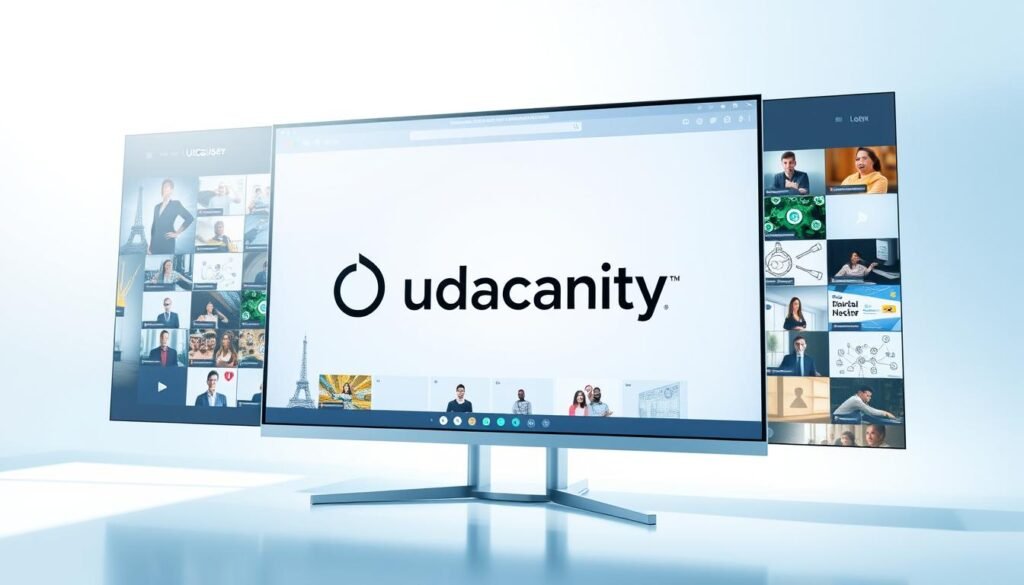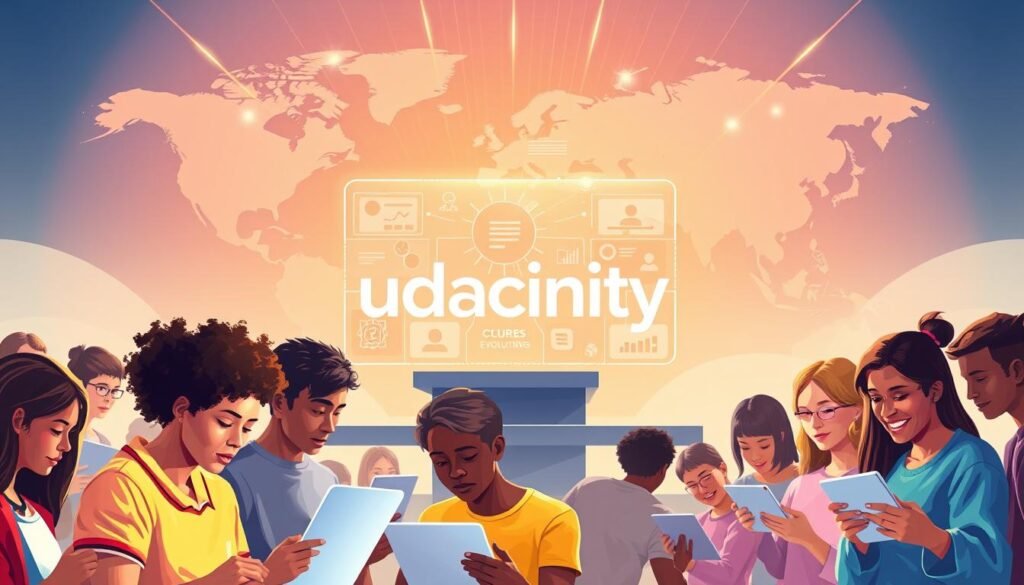What if you could gain in-demand tech skills directly from industry leaders—without stepping into a classroom? Udacity makes this possible. Founded in 2011 by Sebastian Thrun, this online education pioneer has transformed how professionals learn cutting-edge skills.
The company offers 78 nanodegrees in fields like AI, cloud computing, and data science. With over 1.6 million users globally, Udacity partners with giants like Google and NVIDIA to deliver job-ready training. In 2024, Accenture acquired it, integrating its programs into the LearnVantage platform.
Udacity’s hands-on approach helps learners build skills fast. Whether you’re upskilling or switching careers, its project-based courses ensure real-world readiness. Ready to explore how this platform can accelerate your growth?
Key Takeaways
- Founded in 2011, Udacity specializes in vocational tech education.
- Offers 78 nanodegrees in high-demand fields like AI and data science.
- Partners with top companies including Google and NVIDIA.
- Acquired by Accenture in 2024 for broader corporate training integration.
- Focuses on practical, job-ready skills through project-based learning.
What Is Udacity?
A Stanford experiment sparked a revolution in online education. In 2011, Sebastian Thrun launched the platform after his free AI courses attracted 160,000 students worldwide. This proved demand for accessible, expert-led learning.

The Origins of Udacity
The name blends “audacious” and “university”—reflecting bold goals for learners. Originally, the company offered free MOOCs (Massive Open Online Courses) with academic partners.
By 2013, Udacity made strategic changes. It shifted focus to vocational tech training, partnering with industry leaders like Google. This move aligned education with job market needs.
Udacity’s Mission and Vision
Today, the company bridges the digital skills gap through project-based programs. Its nanodegrees replace traditional degrees with faster, job-ready training.
From free courses to premium service, Udacity adapts to empower careers in tech. Its vision? Democratize high-quality education for all.
Udacity’s Evolution in Online Education
Global access to tech skills became a reality with innovative online education models. The company grew rapidly, reaching 203 countries by 2012. This expansion marked the first of many strategic changes.

From Stanford to Global Reach
What began with 160,000 AI students soon surpassed 21 million learners. A landmark 2014 partnership with Georgia Tech introduced a $7,000 MOOC-based CS master’s degree. This proved online programs could rival traditional education.
By 2017, AR/VR initiatives with Unity and Google scholarships further diversified offerings. The platform cemented its reputation for cutting-edge tech training.
Pivoting to Vocational Training
Udacity’s 2018 cybersecurity nanodegree addressed urgent industry needs. The shift from academic MOOCs to job-ready programs defined its new direction.
After Accenture’s 2024 acquisition, the company integrated into LearnVantage. This move expanded corporate training offerings, aligning with workforce demands.
Udacity’s Course Offerings
Tech professionals now have flexible options to master in-demand skills through structured online courses. Whether you’re exploring basics or diving deep into specialized fields, the platform caters to varied learning needs.

Free Courses vs. Paid Nanodegrees
Initially, free classes like Python and robotics attracted millions. Today, premium nanodegrees ($200–$400/month) dominate, offering job-ready training. These intensive programs include mentor support and hands-on projects.
While free courses remain for foundational skills, nanodegrees provide career-focused depth. The discontinued Nanodegree Plus once guaranteed jobs, but current programs emphasize portfolio-building for employer appeal.
Popular Topics and Industry Partnerships
Top domains include AI engineering, data science, and cloud computing. Corporate giants like AWS and IBM co-create content, ensuring relevance to market needs.
Localized versions in Arabic, Spanish, and Korean expand access. Pearson VUE proctoring adds credibility for professionals seeking certifications.
Udacity’s Nanodegree Programs: Bridging the Skills Gap
The demand for job-ready tech professionals has never been higher, and specialized programs are stepping up. With an 89% career impact rate, these intensive courses focus on real-world skills employers need.

What Makes Nanodegrees Unique?
Unlike traditional courses, nanodegrees use project-based learning. Students build portfolios with scenarios like fraud detection algorithms or cloud migration plans.
The platform pairs learners with mentors for code reviews and career advice. Over 300 hiring partners, including AT&T, actively recruit graduates.
Success Stories and Career Outcomes
According to the 2022 Graduate Outcomes Report, alumni see a $15K average salary boost. AT&T alone hired 1,000+ interns from the program.
Many professionals transition to FAANG companies or Fortune 500 firms. Scholarships have empowered 50K+ learners to access these offerings.
The Accenture Acquisition: What It Means for Udacity
Corporate learning just got a major upgrade with Accenture’s strategic move. In March 2024, the undisclosed deal brought 230+ Udacity experts into Accenture’s fold. This acquisition merges Udacity’s tech-focused programs with LearnVantage’s enterprise-ready platform.

Expanding Learning Opportunities with LearnVantage
Accenture’s 742K-employee infrastructure now hosts Udacity’s training programs. Fortune 500 clients access tailored courses in AI and cloud computing. The integration boosts AI curriculum development, leveraging Accenture’s R&D resources.
Localized programs will launch in 120+ countries. This addresses the $1.5B corporate training market gap. Partnerships with NVIDIA and AWS ensure cutting-edge content.
Future Prospects Under Accenture
The company plans to scale B2B offerings through LearnVantage’s network. Expect hybrid learning models blending Udacity’s projects with Accenture’s mentorship.
For professionals, this means globally recognized certifications. For enterprises, it’s a turnkey upskilling solution. The merger redefines how tech talent is built at scale.
Conclusion
With an 80% completion rate, this model proves online education can deliver real results. Udacity’s journey—from Stanford MOOCs to Accenture’s LearnVantage—shows how vocational training adapts to workforce demands.
The platform excels with industry-aligned content and a 4.8/5 learner rating. Its project-based approach builds in-demand skills faster than traditional methods.
Explore AI or cloud nanodegrees to advance your career. Free courses remain for foundational learning, while premium programs offer mentor-led depth. Start bridging the skills gap today.
FAQ
What types of courses does Udacity offer?
Udacity provides expert-led online courses, including free introductory classes and paid Nanodegree programs. These focus on high-demand skills like AI, data science, and programming.
How does Udacity’s Nanodegree differ from traditional courses?
Nanodegrees are project-based, industry-aligned programs designed with companies like Google and IBM. They emphasize hands-on learning and career-ready skills.
What happened after Accenture acquired Udacity?
The acquisition integrates Udacity into Accenture’s LearnVantage platform, expanding access to tech training for professionals and enterprises worldwide.
Are Udacity courses suitable for beginners?
Yes! Courses range from beginner to advanced levels. Free introductory content helps newcomers, while Nanodegrees offer structured paths for skill mastery.
How do Udacity’s partnerships impact course quality?
Collaborations with top firms like AWS and NVIDIA ensure curriculum relevance. Courses are frequently updated to reflect industry trends and tools.
Can Udacity programs help with career advancement?
Absolutely. Many graduates report promotions, job transitions, or higher salaries. Career services like resume reviews and mentorship boost outcomes.
